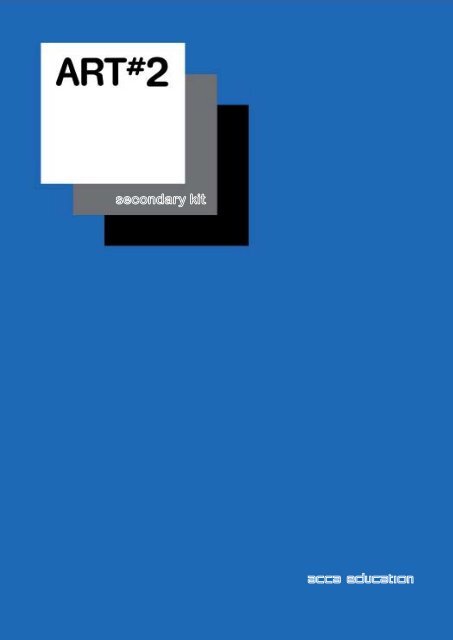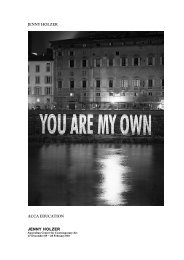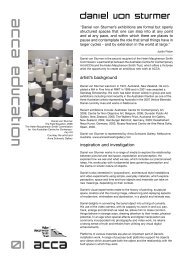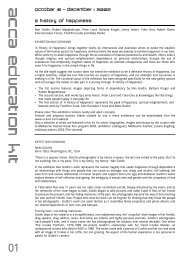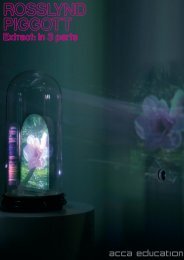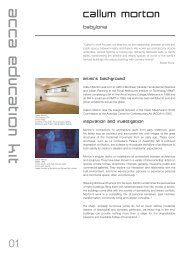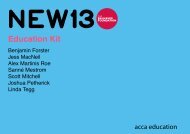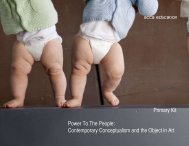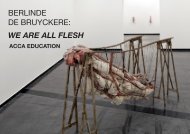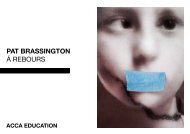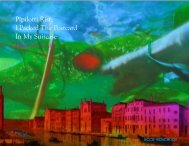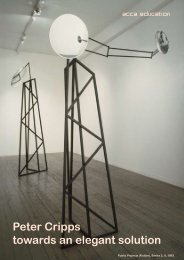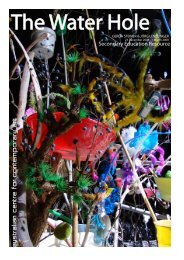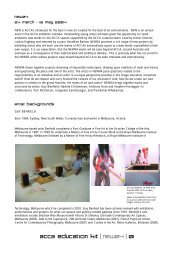Untitled - ACCA
Untitled - ACCA
Untitled - ACCA
- No tags were found...
You also want an ePaper? Increase the reach of your titles
YUMPU automatically turns print PDFs into web optimized ePapers that Google loves.
SECONDARY EDUCATION KITHamilton Art Gallery is renowned for its historic and contemporary collections of fine and decorative arts. Establishedin 1961 following a large bequest by Herbert Buchanan Shaw (1882-1957), today the rich and diversecollection of silver, glass and porcelain, oriental ceramics, tapestries, furniture, paintings and prints is exhibitedin six modern galleries.ART#2 is the Australian Centre for Contemporary Art (<strong>ACCA</strong>)’s second year of bringing the latest new worksfrom Melbourne’s leading contemporary art space to regional Victoria.Visiting Horsham, Hamilton and Warnambool in 2011, <strong>ACCA</strong> has devised programs to suit the collections, audience,architecture and ambitions of each of the galleries. For Hamilton, artists Alex Pittendrigh and Kate Dawrespond to the gallery’s decorative art collection and the rich local history of the community.<strong>ACCA</strong> is Australia’s major centre for contemporary art, which showcases the latest developments in the nationaland international contemporary art scenes. It also acts as an essential facilitator for emerging Australiancontemporary artists and over the past eight years has commissioned over 60 new works.Alex PittendrighKate Daw
Alex Pittendrigh (b. 1966) lives and works in Melbourne. He completed a Bachelor of Fine Arts from the VCAin 1994. In 2009 he won the Royal Bank of Scotland Emerging artist award and has been the recipient ofseveral other grants, residencies and awards. He has exhibited widely in Australia, including a solo show at<strong>ACCA</strong>@Mirka Tolarno (2008) as well as internationally in London and Rome.PRACTICEPittendrigh’s practice spans across painting, drawing, installation and sculptural objects crafted from everydaymaterials. He is particularly well known for his delicate Blu-Tack sculpture works. In 2005 Pittendrigh created‘Work and Days at Clubs: Four Sculptural Propositions’. This project was an open studio work in progress, inwhich the artist created a new work each day using discarded materials such as vacuum cleaner dust, plasticcable ties and Blu-Tack. These ephemeral installations evolved throughout the exhibition, and demonstratedPittendrigh’s focus on the process of art making. His inspiration for using Blu-Tack comes from observations ofoffice distraction and daydreaming.“Blu-Tack is commonly used in all sorts of office practices. I did work for a number of years as a foot courierin the city and in that time I visited nearly every office in the Melbourne CBD and I often did see people makingsmall animals and other things out of Blu-Tack which they would stick above their computer keyboard or on topof their screens or something like that. There was this microscopic world of tiny personal practices on companytime going on all around so that’s one thing that stuck in my mind long time, long before I even thoughtabout using Blu-Tack for this show.” Alex PittendrighPittendrigh’s delicate, floral Blu-Tack creations are reminiscent of the early rococo style, likened to the chinoiseriethat appeared in decorative arts at the time. While exquisitely detailed and reflecting his interestin ornamentation, they also function similarly to doodling, growing out of the subconscious, documenting thewanderings of the mind.ART#2Alex Pittendrigh will undertake a two-week residency in the Hamilton Art Gallery creating a major Blu-Tack wallmural that responds to the Hamilton Art Gallery’s decorative art collection. Created in situ, the project willcontinue his foray into highly decorative, filigree works made using Blu-Tack. The artist will work in the galleryspace during opening hours, making a single work each day in response to a work from the collection. With hisresidency in Hamilton taking place over the 2 weeks of the July school holidays, Alex anticipates one of thesepanels will also be made through a workshop with local kids. Culminating in approximately 15 panels (125 x 58cm each) this series will be presented as a wall work in the gallery’s Ashworth Gallery.
Kate Daw (b.1966) lives and works in Melbourne. She has a PhD fromthe University of Melbourne (VCA&M) and degrees from the VCA,Glasgow School of Art and RMIT University. She has shown in recentexhibitions at <strong>ACCA</strong>, VCA and NGV, and in 2006 held a solo exhibition,The Between Space, at the Art Gallery of Western Australia. Kate hasreceived many awards and grants including the prestigious SamstagScholarship. She has undertaken a residency at the Asialink studio inIndia and has exhibited her work extensively, both nationally and internationally.PRACTICEDaw’s wide-ranging practice includes ceramics, embroidery, painting,photography, printing, sculpture and installation. She often remakesfamiliar objects adding details and irregularities to create a slippage betweenthe everyday and the unfamiliar. In The Between Space (2005)Daw created a large series of ceramic domestic cups and saucers,appropriated from five originals that she selected for their significanceto person, place, association and time. The audience is able to associatethese 1930’s style teacups, modern French coffee cups and officemugs with their own experiences, evoking reminiscence and nostalgia.“I was wanting the work to look like cups and saucers set out for a functionor something like that, and the viewer not being certain about whatthey are looking at – is it art or are they for a conference? Those linesbetween art and real life are questions I am really interested in lookingat, how art can act as a trigger for viewers’ own narrative experiences.”Kate DawIn other works Daw uses text from a variety of sources, often descriptiveand detailed, stimulating memories and sensory experiences andallowing the audience to create their own mental pictures and narrativejourney.ART#2For the ART#2 project, Daw will spend time in Hamilton, immersingherself in the local history and craft. Her project will encompass fourkey components comprising visual and text elements responding to thearchitecture of the Ashworth Gallery where the works will be exhibited.Daw will work with the local Hamilton Embroiders Guild to create asmall embroidery, based on an unrealised garden plan by Edna Wallingoriginally designed for Dame Nellie Melba. The embroidery will bedisplayed aside a photographic document of an existing local gardendesigned by Walling. Edna Walling (1895-1973) is regarded as oneof the most influential landscape designers of her time, renownedfor transforming Australia’s ideas of gardening. Daw will also exhibitphotographic documentation of 2 plates, one owned by her mother andanother owned by her aunt. These two images will be accompanied bya series of hand-made ceramic works by the artist and a didactic textthat layers factual information with a creative response. A coat drawnfrom the Hamilton Art Gallery’s costume collection will be displayednext to a text based on an interview with a friend of the artist thatexplores her relationship to a grey coast she made and is now without.The last component is a multi-panel work of small, raw stretched canvaseswith the contents of a Scottish decorative art auction cataloguere-typed in full.
CURRICULUM LINKSVCE ARTUNIT 2 Area of study 1 Outcome 1Rococo InfluenceUse The Formal framework and the Cultural framework to analyse, interpret, compare and discuss Alex Pittendrigh’s Blu-Tackworks, taking into account the materials and techniques used and how they shape and affect the interpretation; the distinctivestylistic qualities of the artwork and how they contribute to meaning; whether the physical aspects or presentation of the artworkcontain symbolic meaning and use of metaphor. How have historical events and artistic movements such as the baroqueand rococo periods shaped and influenced Pittendrigh’s practice and our understanding of the artwork’s meaning.VCE STUDIO ARTUNIT 4 Area of study 3 Outcome 3Arts Industry ContextsExamine and explain the preparation and presentation of artworks in the Hamilton ART#2 exhibition. Investigate The AustralianCentre for Contemporary Art, how it differs from other public institutions and commercial galleries. Research the variousroles, processes and methods involved in bringing the exhibition to a regional gallery, and having an artist work in situ for theaudience to observe and interact with.PHILOSOPHYUnit 2 Outcome 2Other great questions in philosophy – AestheticsVisit ART#2 in order to discuss aesthetics in relation to contemporary art. What defnes the aesthetic? (e.g. exploration ofsuch concepts as ‘taste’, ‘aesthetic properties’, ‘aesthetic experience’, ‘aesthetic appreciation’, and their relationship); What isthe purpose and value of art? To what extent is a society justifed in censoring art? How important is originality in the arts, andshould we condemn forgeries, or even copies? Can we make and defend a distinction between ‘high’ and ‘low’ art?VELSLEVEL 5The ArtsExploring and RespondingEvaluate and interpret artworks from different contexts,• identify stylistic features of Rococo express views on the purposes of these works• use appropriate terms and explain identifying symbols within artworks from this periodCreating and makingExperiment with, select and use appropriate skills, techniques, processes, media, materials, equipment and technologiesacross a range of arts forms and styles.• extend skills in a particular art form by working through ways of manipulating elements such as colour, texture, line etcLearn about the rococo period, focusing on the features of this style in art, design, music etc. Discuss the ways in whichPittendrigh has appropriated this style and how he has reinterpreted it in a contemporary context.Students will gather ideas from rococo imagery and work on cardboard panels to create a highly detailed blutack sculpture.Place all students panels together on a wall to create a group wall sculpture.LEVEL 6The ArtsExploring and RespondingResearch and critically discuss a range of contemporary, traditional, stylistic, historical and cultural examples of arts worksfrom the Hamilton Art Gallery collection, in the disciplines and forms in which they are working.Creating and makingCreate arts works devised from a range of stimuli, demonstrating development of a personal style.Students will:Research a particular object or artwork in the Hamilton collection, deciding on a work of interest.Make a series of artworks in response to the chose work. They will experiment with different mediums and use text andvisual components.Present works to class, discussing the way the finished artwork relates to the Hamilton Art Gallery work they focused on.


